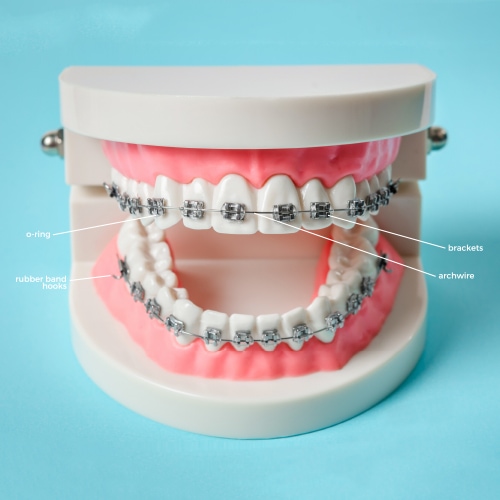Staying Calm During
Orthodontic Emergencies
In the world of orthodontics, emergencies can happen, and when they do, it’s crucial to stay calm. At Factoria Orthodontics, we understand the frustration that comes with unexpected orthodontic issues. These situations can disrupt your day and may necessitate an unscheduled visit to our practice. Rest assured, we’re here to assist you every step of the way.
Most often, orthodontic emergencies can be addressed at home with simple solutions. In fact, 99.9% of these situations can be managed effectively using the emergency care guide that we provide. This guide is designed to help you navigate the situation with confidence and ease, minimizing discomfort and preventing further complications.

However, while our guide is a great starting point, it’s important that we are made aware of any orthodontic emergencies you may encounter. If you find yourself following any procedures in our guide, please call our practice during regular business hours. Our team will provide further guidance, answer any questions you may have, and if necessary, schedule an appointment for you at the earliest available slot. If you prefer to call after hours, feel free to leave a voicemail and we will get back to you as soon as possible.
Your oral health is our top priority. With Factoria Orthodontics, you’re never alone in handling orthodontic emergencies. We’re committed to providing the support and care you need to keep your orthodontic journey on track.
A Major Emergency
There are only a few true orthodontic emergencies. They include:
- Trauma or injury to the teeth, face, or mouth
- Infection or swelling of the gums, mouth, or face
- Severe, unmanageable discomfort or pain
In any of these situations, you should seek help as soon as possible — go to an emergency room, if that’s your best option. Once your safety is assured, contact our office, and we’ll get you in to assess any damage to your appliances.
While serious emergencies are rare, there are a few common orthodontic issues you may face throughout treatment. In the case of any emergency, it is important to remain calm and take precautionary measures until you can see your orthodontist. Some can be resolved at home, but our team is always here to help with any questions or troubles you may experience!

Common Tools & Supplies To Use
With these tools and supplies on hand, you will be prepared to handle the most common orthodontic issues. Many of these can be found around the house or easily picked up from your local store:
- Orthodontic relief wax
- Dental floss
- Disinfected tweezers
- Q-tips
- Salt
- Interproximal brush
- Toothpicks
- Over-the-counter pain reliever(such as acetaminophen or ibuprofen)
- Topical Anesthetic(such as Orabase or Ora-Gel)
Common Orthodontic Issues
Lost O-Ring
If your braces have a bracket or band with an O-ring that has fallen off, you can replace it temporarily by using a pair of tweezers. Before placing the new o-ring, make sure to clean the bracket or band. If you’re having trouble placing the o-ring back on, do not force it. Contact our team for guidance and we’ll schedule an appointment if necessary.
Poking or Protruding Wire
While annoying and uncomfortable, a poking wire can occasionally happen for various reasons. You can try moving the wire into a better position with a pencil eraser or a Q-Tip. If the wire won’t move, you may be able to cut the end off with a nail clipper sterilized in alcohol — but before doing so, please call our office for guidance. Often, you can also use tweezers to gently move a misplaced wire or a tie that’s causing problems.
When wires or brackets cause irritation, covering the metal parts with wax will often help ease the discomfort until you come in. As with any of these types of problems, call our office and we’ll schedule a time to fix the issue.
Loose Brackets or Bands
A loose bracket or band is a normal occurrence that occasionally may happen during orthodontic treatment and is often caused by chewing on or eating something you shouldn’t. If you have a loose bracket, try using orthodontic wax to temporarily secure it in place. Do not attempt to remove the bracket yourself as it may cause damage to your teeth or braces. Contact our team right away so we can get you scheduled for a repair.
Irritation & Discomfort
Experiencing irritation and discomfort is not uncommon during orthodontic treatment, especially when you first get your braces or aligners. The inside of your mouth may need some time to adapt to the new appliances. The wires, brackets, or edges of the aligners can sometimes rub against the inside of your mouth and lips, causing discomfort. You can alleviate this by applying orthodontic wax to the irritating areas. The wax provides a smooth surface and reduces friction, helping your mouth adjust. Rinsing with warm salt water can also help soothe any irritation in your mouth. Over-the-counter pain relievers can be beneficial too for any soreness. Most importantly, remember that any initial discomfort is temporary and usually subsides within a few days. If discomfort persists, please reach out to our team.
Soreness
Braces, and even Invisalign, when first installed or adjusted, can often cause temporary soreness in your mouth. This is a normal occurrence that usually subsides within a few days. To manage this discomfort, consider rinsing your mouth with warm salt water, which aids in soothing the mouth tissues. Over-the-counter pain relievers can also be effective. Cold foods and drinks such as ice cream or smoothies can provide a numbing effect, helping to alleviate the discomfort. It’s essential to maintain good oral hygiene during this time, as a clean mouth heals faster from any irritation. If the soreness persists beyond a reasonable time, please contact our team.
If you have tried all the above options and it has not fixed the issue and would like to speak to someone through our emergency line, please call (425) 515-5049.